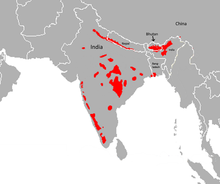เสือโคร่งเบงกอล
| เสือโคร่งเบงกอล | |
|---|---|

| |
| สถานะการอนุรักษ์ | |
| การจำแนกชั้นทางวิทยาศาสตร์ | |
| อาณาจักร: | Animalia |
| ไฟลัม: | Chordata |
| ชั้น: | Mammalia |
| อันดับ: | Carnivora |
| วงศ์: | Felidae |
| สกุล: | Panthera |
| สปีชีส์: | P. tigris |
| สปีชีส์ย่อย: | P. t. tigris |
| Trinomial name | |
| Panthera tigris tigris (Linnaeus, 1758) | |

| |
| การกระจายพันธุ์ของเสือโคร่งเบงกอล | |
| ชื่อพ้อง | |
| |
เสือโคร่งเบงกอล (อังกฤษ: Bengal tiger, Royal bengal tiger; ชื่อวิทยาศาสตร์: Panthera tigris tigris) เป็นประชากรของเสือโคร่งชนิดย่อย[2] จัดให้เป็นหนึ่งในแมวป่าที่ใหญ่ที่สุดเท่าที่ยังมีชีวิตอยู่[3][4] และอยู่ในกลุ่ม charismatic megafauna ของโลก[5]
เสือโคร่งชนิดนี้น่าจะปรากฏในอนุทวีปอินเดียมาตั้งแต่ช่วงอายุไพลสโตซีนตอนปลาย (ประมาณ 12,000 ถึง 16,500 ปีก่อน)[6][7][8] ปัจจุบัน เสือโคร่งชนิดนี้ถูกคุกคามจากการบุกรุกเข้าไปล่าสัตว์, การทำลายและการกระจัดกระจายของที่อยู่อาศัย และประมาณการว่ามีเสือโคร่งในป่าน้อยกว่า 2,500 ตัวใน ค.ศ. 2011 ไม่มี ภูมิทัศน์อนุรักษ์เสือโคร่ง บริเวณใดที่ใหญ่พอที่จะรองรับประชากรเสือวัยผู้ใหญ่มากกว่า 250 ตัว[1]
ขอบเขตในอดีตของเสือโคร่งเบงกอลครอบคลุมถึงหุบเขาลุ่มแม่น้ำสินธุ และเกือบทั่วอินเดีย ปากีสถาน เนปาลตอนใต้, บังกลาเทศ, ภูฏาน และจีนตะวันตกเฉียงใต้ จนถึงช่วงต้นคริสต์ศตวรรษที่ 19 ปัจจุบันพบได้ในอินเดีย บังกลาเทศ เนปาล ภูฏาน และจีนตะวันตกเฉียงใต้[7] ประชากรเสือโคร่งในอินเดียมีประมาณ 2,603–3,346 ตัวใน ค.ศ. 2018[9] มีเสืองโคร่งประมาณ 300–500 ตัวอาศัยอยู่ในประเทศบังกลาเทศ[1] 355 ตัวในเนปาลเมื่อ ค.ศ. 2022[10] และ 90 ตัวอาศัยอยู่ในประเทศภูฏานใน ค.ศ. 2015[11]
ประวัติ[แก้]
เสือโคร่งเบงกอลขึ้นชื่อว่าเป็นเสือโคร่งที่กินมนุษย์มาตั้งแต่อดีต โดยเฉพาะในอินเดีย การล่าเสือเป็นเกมกีฬาของราชวงศ์ชั้นสูง แม้แต่ในยุคที่อังกฤษเข้ามาปกครองอินเดีย โดยการขี่หลังช้างออกล่าในตามทุ่งหญ้าทั้งหญ้าสูงและหญ้าต่ำ ในคริสต์ทศวรรษที่ 20 มีเสือโคร่งเบงกอลคร่าชีวิตมนุษย์ไปกว่า 1,600 รายต่อปี แม้แต่ในปัจจุบันที่การล่าเสือเป็นสิ่งที่ผิดกฎหมาย และผู้คนเข้าใจถึงการอนุรักษ์สัตว์ป่ามากขึ้น แต่ทว่าก็ยังคงมีการโจมตีมนุษย์อยู่เป็นระยะ ๆ ของเสือ โดยเฉพาะในสุนทรวันซึ่งเป็นพื้นที่ป่าชายเลน เสือโคร่งเบงกอลที่นี่มีความดุร้ายและไม่เกรงกลัวมนุษย์ มักจะโจมตีมนุษย์เสมอ ๆ โดยเฉพาะการจู่โจมจากด้านหลัง ชาวพื้นเมืองที่นี่จึงต้องสวมหน้ากากไว้ด้านหลังเพื่อป้องกัน ด้วยการทำให้เสือเข้าใจผิดว่ากำลังถูกจ้องดูอยู่ เสือที่โจมตีมนุษย์ส่วนมากเป็นตัวเมียในช่วงฤดูเก็บน้ำผึ้ง ซึ่งตรงกับฤดูที่เสือโคร่งเบงกอลจะมีลูกพอดี[12]
รูปลักษณ์[แก้]
เสือโคร่งเบงกอลตัวผู้เมื่อมีขนาดใหญ่เต็มที่อาจยาวได้ถึง 360 เซนติเมตร หนัก 250-270 กิโลกรัม ขณะที่ตัวเมียมีขนาดเล็กกว่า และมีน้ำหนักอยู่ที่ประมาณ 140–180 กิโลกรัม
อ้างอิง[แก้]
- ↑ 1.0 1.1 1.2 Goodrich, J.; Lynam, A.; Miquelle, D.; Wibisono, H.; Kawanishi, K.; Pattanavibool, A.; Htun, S.; Tempa, T.; Karki, J.; Jhala, Y. & Karanth, U. (2015). "Panthera tigris". IUCN Red List of Threatened Species. 2015: e.T15955A50659951.
- ↑ Kitchener, A. C.; Breitenmoser-Würsten, C.; Eizirik, E.; Gentry, A.; Werdelin, L.; Wilting, A.; Yamaguchi, N.; Abramov, A. V.; Christiansen, P.; Driscoll, C.; Duckworth, J. W.; Johnson, W.; Luo, S.-J.; Meijaard, E.; O'Donoghue, P.; Sanderson, J.; Seymour, K.; Bruford, M.; Groves, C.; Hoffmann, M.; Nowell, K.; Timmons, Z. & Tobe, S. (2017). "A revised taxonomy of the Felidae: The final report of the Cat Classification Task Force of the IUCN Cat Specialist Group" (PDF). Cat News (Special Issue 11): 66–68.
- ↑ Mazák, V. (1981). "Panthera tigris". Mammalian Species (152): 1–8. doi:10.2307/3504004. JSTOR 3504004.
- ↑ Heptner, V. G. & Sludskij, A. A. (1992) [1972]. "Tiger". Mlekopitajuščie Sovetskogo Soiuza. Moskva: Vysšaia Škola [Mammals of the Soviet Union. Volume II, Part 2. Carnivora (Hyaenas and Cats)]. Washington DC: Smithsonian Institution and the National Science Foundation. pp. 95–202.
- ↑ Sankhala, K. (1978). Tiger: The Story of the Indian Tiger. Glasgow: Collins. ISBN 978-0002161244.
- ↑ Kitchener, A. C. & Dugmore, A. J. (2000). "Biogeographical change in the tiger, Panthera tigris". Animal Conservation. 3 (2): 113–124. doi:10.1111/j.1469-1795.2000.tb00236.x. S2CID 86096562.
- ↑ 7.0 7.1 Luo, S. J.; Kim, J.; Johnson, W. E.; van der Walt, J.; Martenson, J.; Yuhki, N.; Miquelle, D. G.; Uphyrkina, O.; Goodrich, J. M.; Quigley, H. B.; Tilson, R.; Brady, G.; Martelli, P.; Subramaniam, V.; McDougal, C.; Hean, S.; Huang, S.; Pan, W.; Karanth, U.; Sunquist, M.; Smith, J. L. D. & O'Brien, S. J. (2004). "Phylogeography and Genetic Ancestry of Tigers (Panthera tigris)". PLOS Biology. 2 (12): e442. doi:10.1371/journal.pbio.0020442. PMC 534810. PMID 15583716.
- ↑ Cooper, D. M.; Dugmore, A. J.; Gittings, B. M.; Scharf, A. K.; Wilting, A. & Kitchener, A. C. (2016). "Predicted Pleistocene–Holocene rangeshifts of the tiger (Panthera tigris)". Diversity and Distributions. 22 (11): 1–13. doi:10.1111/ddi.12484.
- ↑ Jhala, Y.V.; Qureshi, Q. & Nayak, A.K. (2020). Status of tigers, co-predators and prey in India 2018 (PDF) (Report). New Delhi, Dehradun: National Tiger Conservation Authority, Government of India, Wildlife Institute of India.
- ↑ Sottile, Zoe (31 July 2022). "Nepal has nearly tripled its wild tiger population since 2009". CNN. สืบค้นเมื่อ 1 August 2022.
- ↑ Tempa, T.; Hebblewhite, M.; Goldberg, J.F.; Norbu, N.; Wangchuk, T.R.; Xiao, W. & Mills, L.S. (2019). "The spatial distribution and population density of Tigers in mountainous terrain of Bhutan" (PDF). Biological Conservation. 238: 108192. doi:10.1016/j.biocon.2019.07.037. S2CID 202847357.
- ↑ Killer Tigers, "World's Deadliest Towns". สารคดีทางแอนิมอลแพลนเน็ต ทางทรูวิชั่นส์: ศุกร์ที่ 3 มกราคม 2557
อ่านเพิ่ม[แก้]
- Schnitzler, A.; Hermann, L. (2019). "Chronological distribution of the tiger Panthera tigris and the Asiatic lion Panthera leo persica in their common range in Asia". Mammal Review. 49 (4): 340–353. doi:10.1111/mam.12166. S2CID 202040786.
แหล่งข้อมูลอื่น[แก้]
- "Panthera t. tigris". Cat Specialist Group.
- "Tiger conservation in the Bangladesh Sundarbans". WildTeam. คลังข้อมูลเก่าเก็บจากแหล่งเดิมเมื่อ 6 October 2020. สืบค้นเมื่อ 26 May 2021.
- "Bengal Tiger". Panthera. คลังข้อมูลเก่าเก็บจากแหล่งเดิมเมื่อ 24 September 2015. สืบค้นเมื่อ 24 October 2011.
- Li, Y. & H. Liqiang (2019). "Bengal tigers found in Tibet, with plenty of prey". China Daily.
- "The four faces of the Bengal tiger". Guardian News and Media Limited.
- "Himalayan black bear killed by tiger". Big Cat Rescue. 12 November 2009. คลังข้อมูลเก่าเก็บจากแหล่งเดิมเมื่อ 2021-03-06. สืบค้นเมื่อ 2023-02-06.


